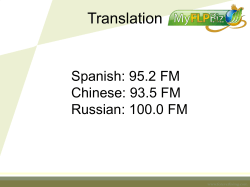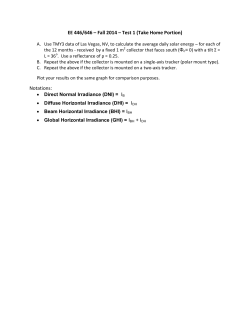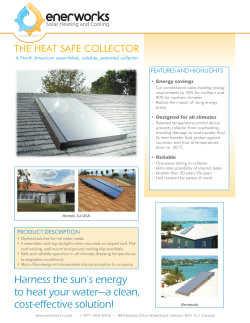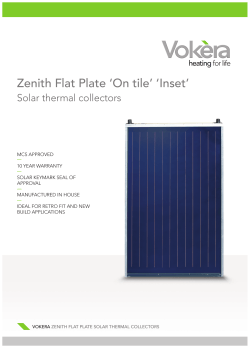
Back absorbing parallel plate polymer absorbers in solar collector
Energy Conversion and Management 43 (2002) 135±150 www.elsevier.com/locate/enconman Back absorbing parallel plate polymer absorbers in solar collector design P.T. Tsilingiris Department of Energy Engineering, Technological Educational Institution (TEI) of Athens, A. Spiridonos Street GR 122 10, Egaleo, Athens, Greece Received 23 December 1999; received in revised form 26 September 2000; accepted 27 January 2001 Abstract Serious eorts are currently devoted towards making solar water heating technology economically competitive. Among them, the development of large, all plastic, innovative design, low cost collector modules suitable for mass production is one of the most promising, which will eventually lead to a drastic reduction of the solar collector subsystem cost. Although appreciable development work was earlier devoted towards production of all plastic solar collectors, the polymer absorber still remains the most crucial part of the polymer collector design, since severe limitations are imposed by the low thermal conductivity of polymers. To overcome these restrictions, a suitable design should be implemented, allowing extended wetted surfaces of the absorbers, something which leads to the familiar extruded parallel polymer plate absorber design. Recent investigations have been directed toward de®nition of the limitations and development of design criteria for the top absorbing parallel polymer plate absorber. In the present work, a subsequent analysis is developed for evaluation of the back absorbing polymer plate design, which allows the absorption of radiation at the water stream and the back plate. The results of the current analysis, which are presented comparatively to those obtained for the top absorbing plate design, show a remarkable improvement of the collector eciency factor and a corresponding reduction of the collector loss coecient, something which leads to a signi®cant improvement of the instantaneous heat collection eciency of collectors using a back absorbing plate absorber design. Ó 2001 Elsevier Science Ltd. All rights reserved. Keywords: Solar polymer absorber; Collector eciency factor; Collector loss coecient 1. Introduction The economic viability of solar thermal conversion technology in the rapidly developing free energy market environment will be based on its competitiveness against conventional energy. The 0196-8904/02/$ - see front matter Ó 2001 Elsevier Science Ltd. All rights reserved. PII: S 0 1 9 6 - 8 9 0 4 ( 0 1 ) 0 0 0 1 5 - 2 136 P.T. Tsilingiris / Energy Conversion and Management 43 (2002) 135±150 Nomenclature A b d C D F0 h k l L m_ m _ M n P q S T U V W area (m2 ) plate thickness (m) plate spacing (m) numerical constant diameter (m) collector eciency factor convective heat transfer coecient (W m thermal conductivity (W m 1 K 1 ) thermal expansion coecient (K 1 ) length (m) unit area mass ¯ow rate (kg m 2 s 1 ) numerical constant mass ¯ow rate (kg s 1 ) numerical constant perimeter (m) unit area energy rate (W m 2 ) solar energy absorption (W m 2 ) temperature (°C or K) loss coecient (W m 2 K 1 ) ¯ow velocity (m s 1 ) width (m) Greeks l viscosity (kg m 1 s 1 ) m kinematic viscosity (m2 s 1 ) q density (kg m 3 ) Subscripts a ambient b back, back plate bf back plate-¯uid interface c collector f ¯uid f1 top plate-¯uid f2 back plate-¯uid h hydraulic L loss p top plate pf top plate-¯uid interface t top u useful gain 2 K 1) P.T. Tsilingiris / Energy Conversion and Management 43 (2002) 135±150 137 relatively low cost of conventional energy during the last decade indicates that the role of developing simple, reliable and low cost systems, employing widely available recyclable materials, will be decisive for the future of this technology. The cost reduction of solar heating plants should mainly be based on drastic cost reduction of the collector ®eld subsystem. Towards this aim, the development of modular, innovative design, all polymer, low cost collectors will eventually allow easy and low cost construction of large collector ®elds with a signi®cant material, labour and plumbing cost reduction. Innovative designs of all polymer collectors have been earlier and more recently proposed and demonstrated [1±4]. According to the theory [5], the useful heat gain of a solar collector can simply be expressed as a function of the mean absorber plate temperature. To allow reference to a localized ¯uid temperature, the collector eciency factor F 0 is de®ned in the familiar Hottel±Willier±Bliss model. Derivation of this factor, which may remarkably aect the collector performance parameters, is based on the assumption of a negligible thermal resistance between the absorber plate and the heat removing ¯uid. Although this assumption is adequately satis®ed for collectors with metal absorbers, it is not always valid for collectors with polymer absorbers with a considerably lower thermal conductivity. Although the use of polymer materials is currently considered very promising for development of large, all plastic solar collector arrays at a remarkably lower cost using mass production processes, their low thermal conductivity may strongly aect the solar absorber eciency and deteriorate the collector performance, unless a special absorber design is implemented. Among them, the most promising is the extruded parallel polymer plate absorber design, which is basically composed of a pair of parallel plates at the top surface of which the incident solar radiation is absorbed. The dissipated heat is transferred through the top polymer plate via conduction into a water stream ¯owing between the plates. The spacing between the plates can, typically, vary from a few millimeters to a few centimeters, depending on the particular collector design. In a recent investigation [6], a heat transfer analysis was performed, which allowed the development of speci®c design criteria and evaluation of the collector performance parameters for this particular absorber design. However, since the top plate conductance is proportional to the thermal conductivity of the polymer material and inversely proportional to the plate thickness, a performance improvement would be expected by a signi®cant reduction of the top absorbing plate thickness, something which is usually impossible, owing to mechanical reasons. However, it would be possible to avoid the undesirable eects of the poor thermal conductance of the top absorbing plate, alternatively by replacing the top dark absorbing plate by a transparent plate. This absorber design allows partial absorption of the incident solar radiation directly by the ¯owing water stream and by the dark surface of the back polymer plate. The purpose of this work is to present an analysis for evaluation of the collector performance parameters for back absorbing polymer absorbers. The collector performance parameters, in particular the collector eciency factor and the modi®ed collector loss coecient in the familiar Hottel±Willier±Bliss model, strongly determines the instantaneous heat collection eciency of solar collectors. The paper also aims to compare both polymer absorber designs through the presentation of comparative performance parameters and collector eciencies of typical solar collectors with back and top absorbing plate absorbers. 138 P.T. Tsilingiris / Energy Conversion and Management 43 (2002) 135±150 2. Material considerations on absorber design Polymers are widely available, low cost materials, which lend themselves to volume production of lightweight, low cost collectors, tolerant to corrosion and freezing temperatures. Many surveys and reports have been focussed on polymers as solar collector materials [7,8]. However, their reliability, durability and long term performance have not generally been fully demonstrated yet for solar heating plants. Since polymer glazings are subject to degradation under the exposure to UV radiation, glass panes were alternatively proposed. Glass not only eliminates the possibility of rapid degradation of the polymer glazing system under environmental exposure but also oers additional UV protection for the collector absorber. A brief review of the thermophysical properties of widely available candidate polymer materials, as derived from various sources [9±11], is presented in Table 1. It is clear that the service temperature determines the application range of the polymer collectors, which can undoubtedly be employed, not only for low and medium service temperatures, up to 50°C, and between 50°C and 80°C, respectively, but also marginally for high (above 80°C) temperatures. The most suitable polymer materials for absorber design have been proved to be those of the polyole®n group, like polyethylene and polypropylene, and of the ethylene±propylene±diene±monomer (EPDM) group, known as synthetic rubbers. The polyole®ns are mainly suitable for manufacturing thermally extruded ¯at rigid absorbers. Flexible tubes or tube strips interconnected by ¯exible webs, suitable for low temperature unglazed pool heaters, have been tested and are being manufactured of EPDM. It is important that the high expansion coecient of polymers should be taken into consideration in the absorber and solar collector design. There is also a relatively signi®cant variation of thermal conductivity between the various polymer materials. For example, the thermal conductivity of high density polyethylene is almost three times as high as that of EPDM. However, it Table 1 Thermophysical properties of various polymer materials (adapted from Refs. [9±11]) Material group Thermo-physical property Polyole®ns kp (W m EPDM 1 K 1 ) (ASTM C177) Material designation Low density Medium density High density Ultra high density 0.33 0.33±0.419 0.46±0.52 0.46 l (K 1 ) coecient of thermal expansion (ASTM D696) 10±22 10 Tmax (°C) Recommended maximum temperature 82±100 kp (W m 1 K 1) 12 10 Tmax (°C) Recommended maximum temperature 125 14±16 10 104±121 0.138±0.159 1 (K 1 ) 5 5 5 11±13 10 121 5 14 10 ± 5 P.T. Tsilingiris / Energy Conversion and Management 43 (2002) 135±150 139 should also be noted that the thermal conductivity of most widely available polymers is, on average, almost three orders of magnitude lower than that of metallic absorber materials, something which makes the complete redesign of the conventional metal absorber absolutely necessary. In recent absorber designs, in order to overcome the poor thermal conductivity of polymer materials, special attention is concentrated towards increasing the absorber surface in direct contact with the heat transfer ¯uid. This is known as the fully wetted absorber design. A good report on the design of polymer absorbers was provided by Madsen and Goss [12]. Among the proposed polymer absorber designs are the EPDM parallel tube design, which was extensively employed as low temperature swimming pool heating collectors, the polymer ®lm water bag absorber in glazed or unglazed collectors and the extruded polymer absorbers oering both good mechanical rigidity as well as extended wetted surfaces for optimal heat transfer. Several design alterations and improvements have been proposed for improved mechanical rigidity of extruded polymer plate absorbers, like the rib connection of plates to withstand hydrostatic forces. 3. Theoretical model and analysis The model of an ordinary ¯at plate collector with an extruded back absorbing plate polymer absorber is shown in Fig. 1, along with the location of the nodes in the corresponding thermal network. The parallel plates of thickness b are located at a distance d apart, and the single glass pane glazing, as well as the collector back insulation, are also shown in this ®gure. The transparent top polymer plate allows transmission of the incident solar radiation and absorption in both the back absorbing plate and in the water ¯owing stream. The dissipated solar heat at the Fig. 1. The model of a single glazed solar collector with a back absorbing parallel plate polymer absorber. In the same plot, the location of nodes of the associated thermal network is shown. Both absorber plates are of thickness b, and they are located at distance d apart (thicknesses not to scale). 140 P.T. Tsilingiris / Energy Conversion and Management 43 (2002) 135±150 back polymer plate is transferred by convection to the ¯uid stream and by combined convection conduction and radiation to the ambient air through the top polymer plate and glazing system. Additional heat losses also occur via conduction and convection radiation through the back polymer plate and thermal insulation to the environment. The heat ¯ow through the polymer plates is assumed to be one dimensional, owing to the large lateral dimensions of the collector module and to the adequate thermal insulation at the collector periphery. The spectral extinction coecient of glass, especially of low iron content quality, is almost uniform at the visible and near Infrared (IR) band of the solar spectrum [13]. According to the existing literature [14,15], although the spectral extinction coecient of most commercially available transparent polymer ®lms and plates varies considerably, depending on their particular type and chemical composition, in the far IR spectrum, it can be taken as uniform in the visible and near IR without signi®cant loss of accuracy. The incident solar radiation undergoes a slight, almost spectrally uniform extinction at the top glass and polymer plates before entering the water ¯ow passage. This amount of energy absorption will be completely ignored in the present analysis, because of either the low extinction coecient or the small thickness of the parallel transparent regions, as is usually assumed in solar collector theory. The water, however, is a strongly selective absorber with very high extinction coecients around a high transmittance window near 0.5 lm. This leads to a substantial selective absorption at the near and far IR part of the solar spectrum, which should be considered explicitly in the calculations. The convective heat transfer coecient between the top or bottom polymer plates and the heat transfer ¯uid may vary considerably, depending on the particular absorber design or operating conditions and mass ¯ow rates. This is due to the fact that for a particular hydraulic diameter of ¯ow passage, de®ned as D 4A=P where A and P are the cross-section area and the wetted perimeter, respectively, and the particular mass ¯ow rate, the Reynolds number may vary considerably. For the extended lateral dimensions of the absorber plate, as happens in the ordinary ¯at plate collectors, the rib connection of the polymer plates is proved to be absolutely necessary to withstand the mechanical loads of hydrostatic origin. However, the presence of ribbing between the plates, which splits the heat transfer ¯uid ¯ow into a number of parallel streams, is not expected to present any signi®cant ¯ow or thermal eects, owing to their small ribbing conductance. Therefore, the eect of the usual rib connections at a fairly long distance apart will be completely ignored in the subsequent analysis without any signi®cant loss of accuracy. The hydraulic diameter of a rectangular ¯ow passage of width W is calculated as D 2d= 1 d=W 1 where d the absorber polymer plate spacing. When d=W ! 0, as usually happens in practice, the hydraulic diameter becomes 2d. Assuming that the mass ¯ow rate through the whole absorber _ and the absorber cross-sectional area is A dW , where W is the width of absorber, the area is M average ¯uid velocity will be calculated as, _ V M= qA 2 The corresponding Reynolds number will be estimated as _ Re V 2d=m 2M= lW 3 P.T. Tsilingiris / Energy Conversion and Management 43 (2002) 135±150 141 However, instead of the mass ¯ow rate, the per unit collector area mass ¯ow rate is usually employed in solar collector theory, de®ned as _ c m_ M=A 4 Assuming that the collector absorber area is Ac WL, the Reynolds number for the ¯ow of the heat transfer ¯uid in the absorber becomes, Re 2L=lm_ 5 Assuming the usual collector mass ¯ow per unit area rates to range between 0.01 and 0.02 kg m 2 s 1 , for large area polymer collector modules with a spacing between plates of about 0.01 m and width to length proportions in the order of 3 3 m2 , the ¯ow is expected to be laminar, and the entry ¯ow length, being between 0.2 and 0.3 m, is expected to be a very small fraction of the collector length. For the laminar ¯ow regime, the theory [16] predicts that the Nusselt number is independent of the ¯uid velocity and Reynolds number. Therefore, for a characteristic length equivalent to the typical plate spacing and for the thermophysical properties of water at typical operating temperatures, the heat transfer coecient corresponding to a circular cross-section is estimated to be around 150 W m 2 K 1 . For lower mass ¯ow rates, at the range between 0.001 and 0.005 kg m 2 s 1 corresponding to low ¯ow collectors, no signi®cant change of the estimated heat transfer coecient is expected, while the entry length is expected to be an order of magnitude shorter. For higher mass ¯ow rates, which are, except for unusual absorber designs, rather unusual in practice, the Reynolds number for ¯ow transition Re 2300 may possibly be exceeded. In this case, the Nusselt number predicted by the theory, which for turbulent ¯ow in circular crosssections is given by the following familiar dimensionless correlation, Nu C Rem Prn 6 with C 0:023, m 4=5 and n 1=3, will be expected to be appreciably higher, corresponding to proportionally higher convective heat transfer coecients. However, for non-circular cross-sections with sharp corners and large aspect ratios, the ¯uid velocity and the corresponding local heat transfer coecient may both vary appreciably around the periphery, approaching their minimum values at the corners. For these conditions, the Nusselt number for the fully developed ¯ow should appropriately be corrected to account for the ¯ow in rectangular cross-sections. The correction factors, proposed by the theory for a circular crosssection, to the Nusselt number are proportional to the aspect ratio of the cross-section [17], so the corrected Nusselt number and the corresponding convective heat transfer coecient becomes, for a rectangular cross-section with d=W ! 0, about twice that expected for a circular cross-section. Therefore, the subsequent analysis was performed for typical convective heat transfer coecients of 75, 150 and 300 W m 2 K 1 , which are expected to cover the whole typical parameter range for practical applications. The heat transfer ¯uid is assumed to be completely opaque to IR radiation, so the heat exchange between the top and back absorber plates can be completely ignored. Referring to Fig. 1, in which the collector model and the thermal network are shown, the steady state heat balance equations for nodes 2±6 are, Ut Tp Ta kp =b Tpf Tp 0 7 142 P.T. Tsilingiris / Energy Conversion and Management 43 (2002) 135±150 hf1 Tf Tpf hf2 Tbf Sb kp =b Tpf Tf Sf hf2 Tbf kp =b Tbf Tf Tb hf1 Tf Tp 0 8 Tpf 9 kp =b Tbf Ub Tb q0 0 Tb 0 Ta 0 10 11 where Sf is the absorbed energy within the thin water layer, which is directly removed by the heat transfer ¯uid, and Sb is the energy absorption at the dark back polymer plate, which can be calculated by using ordinary ray tracing techniques. The spectral composition of diuse radiation, which is usually shifted towards shorter wavelengths, is not generally similar to the direct radiation spectrum. For a ®rst order approach, it would be adequate to assume a uniform spectral composition of both solar radiation components and to treat incident solar radiation as a beam without signi®cant sacri®ce of accuracy. The calculation of Sf and Sb is based on the nature of the optical processes in the solid semi-transparent, uniformly absorbing region and in the liquid strongly selective, absorbing parallel region. Radiation extinction phenomena in the selectively absorbing ¯uid layer depends strongly on its spectral extinction characteristics, as well as on the spectral composition of the incident energy. Although, in general, accurate transmission conditions are dicult to predict, several typical simple theoretical or experimental radiation transmission models have been proposed, which are bound by a theoretically calculated upper transmission model [18]. Although ray tracing techniques are suitable for application in relatively simple systems, they become extremely dicult to apply in more complex optical con®gurations with multiple parallel regions of materials with dierent optical characteristics in contact. In these cases and especially when absorption in parallel regions has to be taken into account explicitly, the eectiveness of the method becomes questionable, owing to the increased number of re¯ection and refraction paths. To overcome this problem, the net radiation method has been developed earlier and recently employed [19] to investigate the radiation absorption in an identical optical system with multiple parallel regions. The analysis is based on calculation of the incoming and outgoing energies at all optical interfaces, which can be directly employed for the calculation of Sf and Sb . Elimination of the variables Tb , Tbf , Tpf and Tp from Eqs. (7)±(11) is possible, ®rst by the elimination of Tp from Eqs. (7) and (8) to get Tpf kp =bUt Ta hf1 Ut kp =bTf kp =bUt hf1 Ut hf1 kp =b 12 In a similar way, eliminating the variable Tp from Eqs. (10) and (11) yields, Tbf Sb Ub kp =b hf2 Ub kp =bTf kp =bUb Ta hf2 Ub hf2 kp =b kp =bUb Solving Eq. (9) for q0 q0 13 Sf yields, Sf Tbf hf2 Tpf hf1 Tf hf1 hf2 14 Substitution of Tpf and Tbf from Eqs. (12) and (13), respectively, in Eq. (14) and after rearrangements and algebraic manipulations yields, P.T. Tsilingiris / Energy Conversion and Management 43 (2002) 135±150 q0 hf2 Ub kp =bSb hf1 Ut Sf kp =b hf2 Ub hf2 kp =b Ub kp =b hf1 Ut hf1 kp =b Ut kp =b hf2 Ub Tf Ta kp =bUb hf2 Ub hf2 kp =b Modifying further Eq. (15) in a more convenient form ®nally yields, hf2 Ub kp =b kp =b q0 Sf Sb hf2 Ub kp =b Ub kp =b Ub kp =b hf1 hf2 Ub hf1 hf2 kp =b hf1 Ub kp =b Ub Ut Tf Ta hf1 hf2 Ut hf1 hf2 kp =b hf2 Ut kp =b 143 15 16 The derived Eq. (16) is the familiar HWB equation which oers the useful heat gain of the collector, q0 Sf F 0 Sb UL Tf Ta 17 where F0 and hf2 Ub kp =b hf2 Ub kp =b Ub kp =b 1 Ub 1 hf2 Ub = kp =b 1 kp =b hf1 hf2 Ub hf1 hf2 kp =b hf1 Ub kp =b UL Ub Ut Ub kp =b hf1 hf2 Ut hf1 hf2 kp =b hf2 Ut kp =b 18 19 Note that the collector eciency factor F 0 in Eq. (18) depends solely on the back loss and convective heat transfer coecients. For appreciably high values of (kp =b), Eq. (18) simpli®es to, F0 1 1 Ub =hf2 20 which becomes close to unity when hf2 Ub , as usually happens for a liquid heat transfer medium. For large enough values of the ratio (kp =b) and hf1 hf2 hf , Eq. (19) becomes UL Ub hf Ut Ub Ut hf 21 in which, for hf Ut and hf Ub , the ratio Ub hf = Ut hf becomes close to unity and the collector loss coecient becomes equal to the sum of the top and back loss collector coecients, Ut Ub . 4. Results and discussion The collector eciency factor, as determined from Eq. (18), is plotted in Fig. 2 against the parameter kp =b for ®xed heat transfer coecients of hf hf2 75 (the pair of solid lines), 150 (the 144 P.T. Tsilingiris / Energy Conversion and Management 43 (2002) 135±150 pair of broken lines), 300 W m 2 K 1 (the pair of dotted lines) and Ub 2 W m 2 K 1 (top line) and Ub 4 W m 2 K 1 (lower line). For each pair of ®xed hf lines, the curves of the lower Ub correspond to higher values of the collector eciency factor F 0 . By partial dierentiation of Eq. (18) in terms of the independent variables Ub and hf2 , it is derived that, oF 0 =oUb hf2 kp =b=hf2 Ub kp =b Ub kp =b2 < 0 22 and 2 oF 0 =ohf2 Ub kp =b Ub kp =b=hf2 Ub kp =b Ub kp =b > 0 23 which con®rms the distribution of the curves in Fig. 2, showing that the collector eciency factor, decreases as the back loss coecient increases. It also con®rms that it increases with a corresponding increase of the convective heat transfer coecient. It can also be seen that the collector eciency factor is almost independent of the kp =b ratio for the range of 200 < kp =b < 1000, irrespective of the parameter values of Ub and hf2 . However, an increase of plate thickness or decrease of plate thermal conductivity leads to a decrease of the plate conductance kp =b. For lower values of the kp =b ratio in the range of 0 < kp =b < 200, the collector eciency factor increases, leading to higher useful collector heat gain. This is due to the additional thermal insulation of the low thermal conductance polymer plate, which contributes to reduction of the back collector insulation losses. It is also important to note, from the same ®gure and for kp =b < 200, that this increase is stronger for higher values of Ub , irrespective of the parameter value of hf2 . Fig. 2. The collector eciency factor plotted against kp =b for a back plate absorber design and convective heat transfer coecients of hf2 75, 150 and 300 W m 2 K 1 corresponding to the solid, broken and dotted lines, respectively. The topmost of each of the pair of uniform hf curves correspond to Ub 2 while the second lower to Ub 4 W m 2 K 1 . P.T. Tsilingiris / Energy Conversion and Management 43 (2002) 135±150 145 In Figs. 3 and 4, the calculated collector loss coecient given by Eq. (19) was plotted against the kp =b ratio for top loss coecients of Ut 3, 5 and 7 W m 2 K 1 and for ®xed back loss coecients of Ub 2 (Fig. 3) and 4 W m 2 K 1 (Fig. 4), respectively. The three solid, broken and dotted lines of each group of ®xed top and back loss coecients correspond to a convective heat transfer coecient between the top or back plate and the heat transfer ¯uid of hf1 hf2 hf 75, 150 and 300 W m 2 K 1 , respectively. As the scales in both plots are the same, it can be seen clearly that the collector loss coecient is more sensitive to the convective heat transfer coecient Fig. 3. The collector loss coecient plotted as a function of kp =b for convective heat transfer coecients, as a parameter, of hf1 hf2 hf 75, 150 and 300 W m 2 K 1 corresponding to solid, broken and dotted lines, respectively, as well as for top loss coecients of Ut 3, 5 and 7 W m 2 K 1 and a ®xed back loss coecient of Ub 2 W m 2 K 1 . Fig. 4. The collector loss coecient plotted as a function of kp =b for a convective heat transfer coecients, as a parameter, of hf1 hf2 hf 75, 150 and 300 W m 2 K 1 corresponding to solid, broken and dotted lines, respectively, as well as for top loss coecients of Ut 3, 5 and 7 W m 2 K 1 and a ®xed back loss coecient of Ub 4 W m 2 K 1 . 146 P.T. Tsilingiris / Energy Conversion and Management 43 (2002) 135±150 for the lower ®gure of the back loss coecient of 2 W m 2 K 1 , as it may comparatively be seen by the spacing between the ®xed top loss coecient lines of each group. It can also be seen that although, for the region of 200 < kp =b < 1000, the collector loss coecient is only slightly dependent on kp =b, it sharply decreases for kp =b much lower than 200. This is attributed to the initial assumption of negligible radiation absorption at the top transparent polymer region, owing either to a low extinction coecient or a relatively small plate thickness. However, for very thick top polymer plates, the extinction, practically, cannot be assumed to be negligible. This may lead to signi®cant absorption losses at the top transparent plate and reduction of the energy absorption at the back polymer plate, something which is expected to reduce the sharp decrease of the collector loss coecient for kp =b < 200 and will possibly tend to eliminate the performance improvement, owing to reduction of the absorber plate conductance. To relax the assumptions of equal convective heat transfer coecients between the top and back absorber plates and the heat transfer ¯uid, the calculations were repeated for the ratios hf2 =hf1 0:5 and hf2 =hf1 2 for a back convective heat transfer coecient of hf2 150 W m 2 K 1 , and the results were plotted in Fig. 5. In this plot, the collector heat loss coecient is shown as a function of the kp =b ratio for a ®xed back loss coecient of Ub 2 W m 2 K 1 and top loss coecients of Ut 3, 5 and 7 W m 2 K 1 as a parameter. In each group of lines, corresponding to hf2 =hf1 0:5 (broken lines) and hf2 =hf1 2 (dotted lines), additional results corresponding to hf2 =hf1 1 (solid lines) are also shown for comparison. An inspection of Fig. 5 shows again the familiar behaviour of a sharp decrease of the collector loss coecient in the region of 0 < kp =b < 200, as well as the eect of the parameters Ut and Ub on the collector loss coecient. It can be seen clearly that the solid lines hf1 hf2 150 W m 2 K 1 are located, as expected, between the broken hf1 300 and dotted hf1 75 W m 2 K 1 lines, re- Fig. 5. The eect of convective heat transfer coecient imbalance on collector loss coecient plotted against kp =b for Ut 3, 5 and 7 W m 2 K 1 and ®xed Ub 2 W m 2 K 1 and hf2 150 W m 2 K 1 . Solid lines correspond to hf2 150 W m 2 K 1 while broken and dotted lines correspond to hf2 300 and 75 W m 2 K 1 , respectively. P.T. Tsilingiris / Energy Conversion and Management 43 (2002) 135±150 147 spectively, since higher or lower convective heat transfer coecients between the top transparent plate and the ¯uid stream leads to higher or lower, respectively, top plate temperatures. The eect of the convective heat transfer coecient from the top absorbing plate is stronger for the higher top loss coecients, as seen by the spacing between the broken and dotted lines, owing to the proportionally higher top heat losses. In Figs. 6 and 7, comparative results are presented for the collector eciency factor F 0 and collector loss coecient UL , respectively, for the top and back absorbing plate polymer absorber design. The results of the current analysis are presented in both plots by solid lines compared with those of a recent investigation [6], corresponding to the alternative top absorbing plate design plotted by broken lines. In Fig. 6, the collector eciency factor is plotted as a function of kp =b for a collector with Ub 4 W m 2 K 1 and hf 150 (top solid line) or 75 W m 2 K 1 (lower solid line). In the same plot, the corresponding values of the same parameter for the top absorbing plate design with Ut 7 W m 2 K 1 and hf 150 (top broken line) or 75 W m 2 K 1 (lower broken line) are comparatively shown. It is clear that not only the back absorbing plate absorber design leads to almost 20% higher F 0 values for the whole range between 200 < kp =b < 1000 but also leads to an opposite eect and far higher values of the same parameter in the range of 0 < kp =b < 200. In Fig. 7, the collector loss coecient UL is plotted as a function of kp =b for a collector with Ut 7, Ub 4 W m 2 K 1 and hf 150 (top solid line) or 75 W m 2 K 1 (lower solid line). In the same plot, corresponding values of the same parameter UL for the top absorbing plate absorber design are also comparatively shown for hf 75 (top broken line) or 150 W m 2 K 1 (lower broken line). It is clear that not only the collector loss coecient for the back absorbing plate absorber design is, on average, 15% lower than the corresponding value for the top absorber plate Fig. 6. Comparative presentation of the collector eciency factor as a function of the ratio kp =b for the back absorbing (solid lines) and top absorbing (broken lines) parallel plate polymer absorber designs for Ut and Ub ®xed at 7 and 4 W m 2 K 1 , respectively. The top line of each group corresponds to hf 150 W m 2 K 1 while the lower line corresponds to hf 75 W m 2 K 1 . 148 P.T. Tsilingiris / Energy Conversion and Management 43 (2002) 135±150 Fig. 7. Comparative presentation of the collector loss coecient as a function of the ratio kp =b for the back absorbing (solid lines) and top absorbing (broken lines) parallel plate polymer absorber designs for Ut 7 W m 2 K 1 and Ub 4 W m 2 K 1 . The top and lower solid lines correspond to 150 and 75 while the top and lower broken lines correspond to 75 and 150 W m 2 K 1 , respectively. design in the range of 200 < kp =b < 1000 but also exhibits the same opposite eect and leads to far lower values of UL for the very low values of kp =b ranging between 0 < kp =b < 200. Since the instantaneous heat collection eciency of a solar collector is strongly determined by the performance parameters, through the linear Hottel±Willier±Bliss model, it would be important to quantify the collector performance improvement owing to the calculated higher values of UL and F 0 for the back absorbing plate absorber design. For this reason, the eciency lines corresponding to a collector with a back (solid line) and a top (broken line) absorbing plate absorber were plotted in Fig. 8 as a function of the ratio Tf Ta =G for ®xed values of the collector performance parameters san and UL and for kp 0:3 W m 1 K 1 , hf 100 W m 2 K 1 and b 3 mm. The selected values of the collector performance parameters san 0:85 and UL 8 W m 2 K 1 correspond to a conventional single glazing ¯at plate collector design. To simplify the comparison, the temperature distribution in the ¯ow direction of the collector was completely ignored, so the Hottel±Willier±Bliss model in terms of the average ¯uid temperature Tf becomes, g san F 0 UL F 0 Tf Ta =G 24 In the same plot, the performance line for an ordinary single glazing ¯at plate collector with a conventional copper sheet absorber was comparatively plotted by a dotted line for identical san and UL parameters. In this case, for a 1 mm sheet and 10 mm diameter copper tubes 6 cm apart, the theory [5] predicts that F 0 0:872, which leads to san F 0 0:741 and UL F 0 6:976 W m 2 K 1 . As is comparatively shown, there is an appreciable, almost 14%, performance improvement for the back compared to the top absorbing plate collector, which has a collection eciency almost identical to that of an ordinary metal absorber. P.T. Tsilingiris / Energy Conversion and Management 43 (2002) 135±150 149 Fig. 8. Comparative presentation of the instantaneous heat collection eciency of a solar collector with a back absorbing (solid line) and top absorbing (broken line) parallel plate polymer absorber for b 3 mm. In the same plot, the comparative performance of a conventional plate and tube, metal absorber collector design is shown (dotted line) for san 0:85, hf 100 and UL 8 W m 2 K 1 . 5. Conclusions Although polymers are potential low cost materials suitable for mass production of low cost modular solar arrays, their general characteristic of low thermal conductivity makes them marginally suitable for the design and manufacturing of polymer solar energy absorbers, unless a suitable design can be employed. Among the various designs, the extruded polymer plate absorber appears to be very suitable for large, all polymer, low cost collector modules. However, owing to the low thermal conductivity of polymer plates, there are certain design limitations for the top absorbing plate absorber, which can be completely eliminated when the top plate of the extruded parallel plate absorber is transparent. The present investigation was devoted to evaluation of the performance parameters for a collector with a fully wetted, back absorbing, parallel polymer plate absorber design. This improved absorber design allows absorption of the radiation at the back polymer plate and in the ¯owing water stream, something which eliminates the adverse eects of the low top absorbing plate conductance on collector performance and leads to an improved collector eciency. According to the derived results, the collector eciency factor and the collector loss coecient for the collector with a back absorbing plate absorber is almost 20% higher and about 15% lower than the corresponding parameters for the top absorbing plate absorber. This collector eciency factor improvement and collector loss coecient reduction were found to lead to a substantial instantaneous collector heat collection eciency increase in the order of 14%, uniformly over a wide range of operating conditions. 150 P.T. Tsilingiris / Energy Conversion and Management 43 (2002) 135±150 References [1] Guinn GR, Hall BR. Solar production of industrial process hot water using shallow solar ponds. Proc Solar Industrial Process Heat Symp., 1977. p. 161±9. [2] Casamajor AB. The application of shallow solar ponds for industrial process heat: case histories. Proc AS/ISES Silver Jubilee Congress, Atlanta, GA, 1979. p. 1029±32. [3] Clark AF, Dickinson WC. Shallow solar ponds. In: Dickinson WC, Cheremisino PN, editors. Solar energy technology handbook: part A. New York: Marcel Decker; 1980. p. 377±402. [4] Tsilingiris PT. Design, analysis and performance of low-cost plastic ®lm large solar water heating systems. Solar Energy 1997;60(5):245±56. [5] Due JA, Beckman WA. Solar engineering of thermal processes. New York: Wiley; 1980. [6] Tsilingiris PT. Heat transfer analysis of low thermal conductivity solar energy absorbers. Appl Thermal Engng 2000;20:1297±314. [7] Waksman D, Dawson A. The in¯uence of environmental exposure on solar collectors and their materials. Proc AS/ ISES Conf 1980;3.1:415±9. [8] Best D. New plastics head for higher temperatures, Solar Age 1982:51±2. [9] Baumaister Th, Avallone E, editors. MarkÕs standard handbook for mechanical engineers. New York: McGraw Hill; 1978. [10] Materials reference issue, Machine Design, 1979;51(6). [11] Gartman H, editor. De Laval engineering handbook. New York: McGraw Hill: 1970. [12] Madsen P, Goss K. Report on nonmetallic solar collectors. Solar Age 1981;6(1):28±32. [13] Dietz AGH. In: Hamilton RW, editor, Diathermanous materials and properties of surfaces in space heating with solar energy, Cambridge, MA: MIT Press; 1954. p 25±43. [14] Fundamental materials considerations for solar collectors. Zerlaut GA. In: Dickinson WC, Cheremisino PN, editors. Solar energy technology handbook,: part B. New York: Marcel Decker; 1980. p. 403±37. [15] Du Pont Company, TEDLAR PVF ®lm Technical Bulletin TD-5, 1985. [16] Incropera F, DeWitt D. Fundamentals of heat and mass transfer, New York: Wiley; 1985. [17] Kays WM. Convective heat and mass transfer. New York: McGraw-Hill; 1966. [18] Tsilingiris PT. An accurate upper estimate for the transmission of solar radiation in salt gradient ponds. Solar Energy 1988;40(1):41±8. [19] Tsilingiris PT. On optical performance and directional characteristics of plastic ®lm liquid layer solar water heaters. Solar Energy 1998;63(5):293±302.
© Copyright 2025









